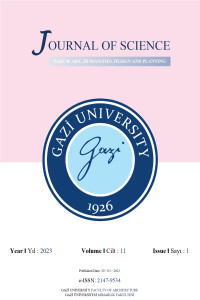Abstract
Supporting Institution
MSGSÜ Fen Bİlimleri Enstitüsü İç Mimarlık bölümünde Dr. Öğr Üyesi Didem Tuncel danışmanlığında yüksek lisans tezi olarak yapılmıştır.
References
- [1] Authors Archive.
- [2] Authors Archive.
- [3] Cüceloğlu, D. (2006). İnsan Ve Davranışı. Remzi Publications
- [4] Varol, E. B. (2004). İnsan-Çevre Etkileşimi Açısından Kamusal Mekanda Sanatın Rolü. Master Thesis. Istanbul Technical University, Institute of Science. İstanbul
- [5] Çelik, M., Aslan, Ş., Koçkan, P. (2013). Teknoloji ve Uygarlık İlişkisinde Mekânların Kimlik Problemi. 2nd National Interior Architecture Symposium. İstanbul: MSGSU Faculty of Architecture, Department of Interior Architecture.
- [6] Özer, B. (2021) Kültür Sanat Mimarlık. YEM Publications. İstanbul. [7] Demir, A. (1981). Çağdaş Teknolojik Gelişmeler. Ankara University Faculty of Political Sciences Publications. No:472
- [8] Hasol, D. (1990). Ansiklopedik Mimarlık Sözlüğü. YEM Publications. İstanbul.
- [9] Ching, F. D. (1996). Architecture: From, Space And Order. United States Of America. Penerbit Willey.
- [10] Usta, G. (2020). Mekan Ve Yer Kavramlarının Anlamsal Açıdan İrdelenmesi. The Turkish Online Journal Of Design Art And Communication, 10(1), 25-30. [11] Kut, S., Aydınlı, S., Erdem, A. (2013). Sibertektonik Mekân. Tasarım+ Kuram Dergisi, 9(15), 21-34. [12] https://www.howarthdesigns.com/inspirations/articles/16_sainte/images/sainte2.jpg [13] http://www.florencia.es/arquitectura-y-arte/los-monumentos/las-iglesias/san-lorenzo [14] Simmel, G. (2019). Modern Kültürde Çatışma. İletişim Publication. İstanbul.
- [15] Mutlu, B. (1996). Mimarlık Tarihi Ders Notları 1, 1st Edition, Mengitan Printing.
- [16] https://www.archdaily.com/397949/ad-classic-the-crystal-palace-joseph-paxton/51d57c57b3fc4b5834000232-ad-classic-the-crystal-palace-joseph-paxton-image?next_project=no
- [17] Mcluhan, M. (2014). Gutenberg Galaksisi Tipografik İnsanın Oluşumu. Yapı Kredi Publications. İstanbul.
- [18] Castells, M. (2021). İnternet Galaksisi. Phoenix Publications. Ankara.
- [19] Virilio, P. (2003). Enformasyon Bombası. Metis Publications. İstanbul.
- [20] Serin, A. P., Akkoy, M. (2020). Bilgi Ve İletişim Teknolojilerindeki Dönüşümün Zaman-Mekânda Sınır Algısına Yansımaları. Tasarım+ Kuram, 16(30), 1-20.
- [21] Gezgin, S., İralı, A. E. (2017). Gelişen Teknoloji Değişen Mekân. Eğitim Publications. İstanbul.
- [22] https://www.arch2o.com/jewel-crown-miguel-chevaliers-complex-meshes-light-durham-cathedral/
- [23] https://www.teamlab.art/w/koi_and_people/
- [24] https://www.teamlab.art/w/waterparticles_bunkanomori/
- [25] https://trendland.com/olfactory-experience-le-grand-musee-du-parfum-paris/
- [26] Baudrillard, J. (2020) Simülakrlar Ve Simülasyon. Doğu Batı Publications. Ankara.
Abstract
The act of perception, which we can define as the process of understanding, making sense of and interpreting the events around us and the patterns existing in the natural and artificial environment takes place as a result of the maturation of a certain mental process. Man, who is in a mutual and intense interaction with his environment, adds new social and physical phenomena to his life by being affected by this new environment he has created as well as changing his environment. Technological developments cause transformations in the parameters of environment, time and space, which are determinants of behavior patterns.
The 21st Century has especially contained developments in which communication technologies have changed their appearance significantly. Software and hardware developments in computer and internet technologies have revealed new concepts of space such as virtual space, cyberspace, hybrid space, and new space concepts have brought new definitions and approaches such as virtual reality, network society, simulator and simulation. The stage where all vital relationships and practices of individuals take place is the spatial plane. Therefore, technological developments that reshape spatial boundaries, organizations and distances determine the perceptions and spatial practices of individuals.
Today, at the point where communication technologies arrive, space continues to gain new meanings as one of the main elements of change, new layers of cyber technologies are added to its physical structure or it comes across as a living organism that virtually exists, changes and transforms itself. In this direction, the research examines the changing space and perception of space within the framework of interior architecture and the influence of technology. It is aimed to reveal the predictions about technology, space and human interaction in the near future with the results of the study based on the literature review, and to lay the groundwork for the studies to be done in order to examine the new interactions that new technologies will bring.
Keywords
References
- [1] Authors Archive.
- [2] Authors Archive.
- [3] Cüceloğlu, D. (2006). İnsan Ve Davranışı. Remzi Publications
- [4] Varol, E. B. (2004). İnsan-Çevre Etkileşimi Açısından Kamusal Mekanda Sanatın Rolü. Master Thesis. Istanbul Technical University, Institute of Science. İstanbul
- [5] Çelik, M., Aslan, Ş., Koçkan, P. (2013). Teknoloji ve Uygarlık İlişkisinde Mekânların Kimlik Problemi. 2nd National Interior Architecture Symposium. İstanbul: MSGSU Faculty of Architecture, Department of Interior Architecture.
- [6] Özer, B. (2021) Kültür Sanat Mimarlık. YEM Publications. İstanbul. [7] Demir, A. (1981). Çağdaş Teknolojik Gelişmeler. Ankara University Faculty of Political Sciences Publications. No:472
- [8] Hasol, D. (1990). Ansiklopedik Mimarlık Sözlüğü. YEM Publications. İstanbul.
- [9] Ching, F. D. (1996). Architecture: From, Space And Order. United States Of America. Penerbit Willey.
- [10] Usta, G. (2020). Mekan Ve Yer Kavramlarının Anlamsal Açıdan İrdelenmesi. The Turkish Online Journal Of Design Art And Communication, 10(1), 25-30. [11] Kut, S., Aydınlı, S., Erdem, A. (2013). Sibertektonik Mekân. Tasarım+ Kuram Dergisi, 9(15), 21-34. [12] https://www.howarthdesigns.com/inspirations/articles/16_sainte/images/sainte2.jpg [13] http://www.florencia.es/arquitectura-y-arte/los-monumentos/las-iglesias/san-lorenzo [14] Simmel, G. (2019). Modern Kültürde Çatışma. İletişim Publication. İstanbul.
- [15] Mutlu, B. (1996). Mimarlık Tarihi Ders Notları 1, 1st Edition, Mengitan Printing.
- [16] https://www.archdaily.com/397949/ad-classic-the-crystal-palace-joseph-paxton/51d57c57b3fc4b5834000232-ad-classic-the-crystal-palace-joseph-paxton-image?next_project=no
- [17] Mcluhan, M. (2014). Gutenberg Galaksisi Tipografik İnsanın Oluşumu. Yapı Kredi Publications. İstanbul.
- [18] Castells, M. (2021). İnternet Galaksisi. Phoenix Publications. Ankara.
- [19] Virilio, P. (2003). Enformasyon Bombası. Metis Publications. İstanbul.
- [20] Serin, A. P., Akkoy, M. (2020). Bilgi Ve İletişim Teknolojilerindeki Dönüşümün Zaman-Mekânda Sınır Algısına Yansımaları. Tasarım+ Kuram, 16(30), 1-20.
- [21] Gezgin, S., İralı, A. E. (2017). Gelişen Teknoloji Değişen Mekân. Eğitim Publications. İstanbul.
- [22] https://www.arch2o.com/jewel-crown-miguel-chevaliers-complex-meshes-light-durham-cathedral/
- [23] https://www.teamlab.art/w/koi_and_people/
- [24] https://www.teamlab.art/w/waterparticles_bunkanomori/
- [25] https://trendland.com/olfactory-experience-le-grand-musee-du-parfum-paris/
- [26] Baudrillard, J. (2020) Simülakrlar Ve Simülasyon. Doğu Batı Publications. Ankara.
Details
| Primary Language | English |
|---|---|
| Subjects | Architecture |
| Journal Section | Architecture |
| Authors | |
| Publication Date | March 29, 2023 |
| Submission Date | December 9, 2022 |
| Published in Issue | Year 2023 Volume: 11 Issue: 1 |


